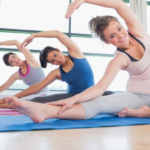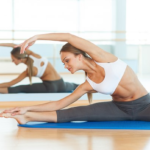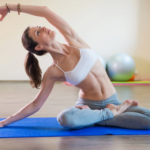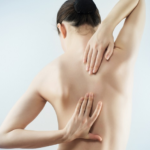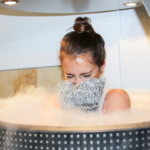A set of exercises for a hernia of the lumbosacral region
A hernia that affects the sacroiliac spine is a complex pathology that requires time-consuming and careful treatment. In the complex of therapeutic measures for this pathology, most doctors also include light motor loads. The use of gymnastics for a hernia of the lumbosacral spine allows the patient to recover faster, normalizes the course of many internal processes. The main thing is to choose the right set of exercises and follow the elementary rules so that the classes are beneficial.
General information about hernia
A hernia in the sacroiliac spine begins to form if there is no normal ratio between the load and reliability of the intervertebral discs. If the loads are excessively high, the cartilaginous skeleton of the intervertebral disc becomes unusable, and its nucleus pulposus is in the spinal canal.
As a result, the patient has the following complaints:
- in the region of the sacroiliac part of the spine, a pain of a aching type appears, aggravated when trying to lift weights, in response to sudden movements, it is usually stopped by painkillers;
- muscle weakness develops, and not only the back muscles weaken, but also the muscles of the lower extremities, which is why the patient's gait is characterized as shuffling;
- with active pressure of the protrusion on the spinal roots, the patient begins to feel numbness in the lower extremities, which can also affect the groin, complaints of goosebumps, tingling of the skin are additionally possible;
- with prolonged clamping of the spinal roots, dysfunction of the pelvic organs develops, for the innervation of which they are responsible.
The development of a hernia requires immediate treatment.
It is wrong to ignore the symptoms, to be treated with folk methods and to postpone going to the doctor. If treatment is delayed, a person may remain disabled, as irreversible changes occur in the hip joints.
What is useful gymnastics
Many people who are faced with a disease and have received recommendations from their doctor are wondering what is the use of therapeutic exercises for hernia? Is there any sense from it, and is it worth spending time on it at all?
Definitely yes, there is a use for gymnastics, and it consists in the following:
- there is a strengthening of the muscular skeleton of the spine, which reduces the load on it;
- it is possible to eliminate muscle spasms, due to which the intensity of pain decreases;
- blood circulation is stimulated, due to which it is possible to eliminate the stagnation of blood in the diseased area and stop the swelling;
- metabolic processes in the cells of the spine and cartilage are improved, which allows them to recover faster.
Doctors have long proven in practice that if you start doing exercise therapy when the first symptoms of a hernia appear, you can avoid the dangerous progression of the disease and, most importantly for many patients, getting on the operating table of the surgeon. It is important to remember that although gymnastics is a fairly safe method, it is still better to entrust the choice of a set of exercises to a specialist. Failure to follow the doctor's recommendations can lead to a deterioration in the patient's condition, the rapid progression of the disease.
The optimal set of exercises
With an intervertebral hernia in the lumbosacral region, the patient may feel a sharp pain that will chain him to bed. Until the pain syndrome is defeated, it is not recommended to move, but the end of bed rest is celebrated with simple exercises that will help prepare the body for more serious stress.
Exercises to prepare the back for stress:
- Focusing on your knees and elbows, stand in bed for a few minutes.
- Having dropped to the floor, they kneel down and, leaning additionally on their palms, thus pass several circles.
In the video, you can also see additional exercises that are performed from the “lying on your back” position on the floor and do not have strict contraindications:
- The legs are placed on the floor, and the arms are laid along the body, and then they make pushing movements in the lower back towards the floor.
- Lie straight with your limbs extended, first raise your head, then your arms and shoulders, and reach for your arms for 10-15 seconds.
- The right leg is pulled up to the chest, the left hand is placed on it and the hand is pushed closer to the chest, while resisting the pushes, then the exercises are performed in the same way, changing the arm and leg.
- They straighten their legs, put their palms on the floor and, raising their heads, stretch to the toes, and try to pull the toes to the head, freezing in this position for 10-15 seconds.
For the spine, you can use another simple complex, consisting of only three exercises:
- Lying on his back with bent legs, the patient performs simple breathing exercises in 12 sets (inhale for eight counts, exhale for four).
- The legs are extended, the arms are still lying flat, the patient needs to raise the body without helping himself with his legs and freeze in this position for 10 seconds, and then lie back down smoothly, rest for 5 seconds and repeat the exercise, up to 15 approaches are done.
- Turning over on his stomach, the patient spreads the limbs to the sides and stretches them as much as possible for 10-15 seconds, then gives himself a rest for 5 seconds and repeats the exercise, 10-12 approaches are required.
Additional exercises
Physical education with intervertebral hernia in the lumbosacral region is not limited to the listed exercises.
You can use the following complex after consultation with a specialist:
- lying on your back, pull the leg bent at the knee to the chest and, clasping it with your hands, press it closer, and then repeat the same actions with the other leg;
- in the same position, now pull both lower limbs to the chest and hug them with your hands, freezing in this position for 10 seconds;
- in addition to the previous exercise, you can raise your head and body, trying to place your chin between your knees;
- raise each leg in turn to an angle of 90º, holding it in this position for 7-10 seconds;
as the spine strengthens, raise the legs not by 90º, but only by 45º, also holding them for 7-10 seconds; - performing "scissors", in which the legs rise to an angle of 90º, and then spread apart and close again, like the blades of a cutting tool;
- exercise "bicycle" in the "lying on your back" position.
To give a greater load, but at the same time not sacrifice the affected vertebra, you can perform an exercise with sipping. To do this, the buttocks are arranged on the heels and, having picked up their hands under themselves, round the back. Having frozen like this for a few seconds, they begin to stretch their arms forward and reach for them, without lifting their buttocks from their heels.
Rules and restrictions
In order for gymnastics for the spine with a hernia of the lumbosacral region to be as effective as possible, a number of simple rules and restrictions must be observed.
These include:
- with any gymnastic exercise, even if it seems quite simple, they carefully monitor their own feelings and, if minimal pain appears, the performance is interrupted (the task is not to do it through force, but to improve health!);
- if at the beginning of some exercises discomfort is felt (not pain!), It can be neglected and the lesson can be continued, since over time the uncomfortable sensations will disappear by themselves;
- a strict restriction in the first months after an exacerbation of a hernia is imposed on exercises with twisting of the spine, as they can harm a person;
- in order for exercise therapy to give an effect, exercises must be performed several times a day, without taking breaks in classes, otherwise their usefulness for the body will be doubtful;
- each daily workout should take at least 20 minutes;
- the restriction is imposed on all sudden movements that can provoke another exacerbation and aggravate the patient's condition.
Gymnastics is a method of dealing with lumbosacral hernia, which has proven itself in medical practice. The correct choice of loads, the gradual addition of new exercises and careful adherence to the recommendations of the attending physician can save the patient from the operating table. Gymnastics can give a suffering person a chance to return to a full, healthy life, if he takes this method seriously.



